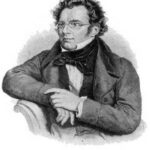Mary Shelley’s Frankenstein explores the idea of the ‘creation of life’. The idea of Frankenstein seems to show how man can go too far in his exploration of what constitutes ‘life’.Frankenstein’ raises the never-ending question of how far is too far in relation to medicine. Frankenstein’s monster is in effect a load of body parts put together to form a new being and I’m sure nearly everybody finds the idea of this utterly horrific though nowadays in medicine it is routine procedure to transplant organs from people dead and alive to others… something to think about.
ABOUT THE AUTHOR
Mary Shelley was subject to many a philosophical discussion about the meaning of life and the many great medical advances of the time as her father was a philosopher; this also meant she was exposed to many of the notable thinkers of her day. Some of Shelley’s childhood was spent living very close to the abattoirs where she would have regularly seen animals being horrifically slaughtered on a regular basis.
She also lived close to a prison where the hanging of convicts was seen as entertainment and there is no limit to the terrible sights she may have been party to there. When Shelley was five or six she heard of experiments being conducted on the bodies of convicts. Electricity was passed through there bodies to make them move (déjà vu?). Philosophy is all about knowledge, ethics and morality; I believe that the ethical lines at the time were definitely blurred as new advances in medicine meant people could effectively experiment on anything or anyone they wanted. All of these ideas of life and death must have had a profound effect on the young Shelley.
It must be noted that parts of Shelley’s life bares an uncanny similarity to the things she wrote of in her novel. Her life was riddled with tragedy and altogether she loses her husband, step-sister and three out of her four children die very young. She also nearly dies in childbirth and her husband’s wife also commits suicide while pregnant. Death is a very definite theme in ‘Frankenstein’.
As a child Shelley was a party to many unconventional ideas as a child and about the nature of life and whether it could be created artificially. It was also suggested in certain discussions that humans rather than God were the masters of the earth: ‘Frankenstein’ definitely embarks upon this idea. It is in reference to the previous point made in my mind no coincidence that the full title of Mary Shelley’s famous work is Frankenstein or The Modern Prometheus. In Greek myth Prometheus stole fire from the Gods so dared to measure himself up as a one of the Gods.
Prometheus punishment was to have his liver plucked out by an eagle everyday and his liver would miraculously grow back every night so the punishment could continue. Similarly Victor Frankenstein also suffers over and over because he dared to become or measure himself up to God. The original concept of Frankenstein was born from the proposal of a ghost story made by Mary’s then husband Percy Bysshe Shelley whilst residing on the shores of Lake Geneva.
THE STORY
Frankenstein retells his story to the explorer Walton and his crew but it is almost as if he is speaking directly to the reader. The story begins with us being introduced to the ambitious explorer Robert Walton the captain of a ship heading for the North Pole; we hear of his dangerous expedition, that though starting successfully starts to turn sour. Walton comes across as an ambitious man who is determined to achieve his goal no matter the consequences, he slightly reminds me of our main character. After we are introduced to Walton we come across a dishevelled, drained Victor Frankenstein who then tells us the epic tale of Frankenstein.
Even though it is Frankenstein recounting the tale to Walton during the novel Frankenstein’s monster becomes the narrator of his specific experiences. I believe this was a conscious decision made by Shelley in order to allow you to understand the plight of the monster: this decision is integral in communicating any kind of sympathy for the monster as Frankenstein’s account is very selfishly all about himself and his terrifying experiences. As both Frankenstein and his monster ‘talk’ to the reader we are given the some-what separate experiences of both of them.
Frankenstein is very selfish in the way he thinks only of himself, his disappointment in the beauty of the monster he tried so hard to create, his terrors, his nightmares, his woes at how the experiment he had dedicated so much time to, had turned out. His blatant disregard for effectively deserting this ‘child’, helpless in the world and his outright rejection of any responsibility for what he has done causes him to lose any of my sympathy. The idea of the monster being a lost child in the world is reinforced by his experiences e.g. , ‘A strange multiplicity of senses seized me, and I saw, felt, heard, and smelt, at the same time; and it was, indeed, a long time before I learned to distinguish between the operations of my various senses.’ Frankenstein almost loses his to be wife not to mention his mind though I still find it very hard to empathize with his egotistic, self-centred character.
Frankenstein’s extreme displeasure in what his creation and effectively his life’s work turned out to be are brought to fruition when we are introduced to the ‘monster’ for the first time. The ‘monster’ absconds from Frankenstein’s apartment and Frankenstein himself is seized by a terrible fever: in which he seems to be tormented by the ‘monster’ he created. Shelley uses at this point a lot of imagery and this is how a lot of the horror felt by the very being of the monster is communicated.
The descriptive language and imagery at this point communicates the horror felt by Frankenstein after creating such a hideous thing. His yellow skin scarcely covered the work of muscles and arteries beneath; his hair was a lustrous black, flowing; his teeth of a pearly whiteness; but these luxuriance’s only formed a more horrid contrast with his watery eyes, that seemed almost of the same colour as the dun white sockets in which they were set, his shrivelled complexion and straight black lips.’ The language is no doubt really quite dated though it is through it’s eloquence that the tale is accurately conveyed. Frankenstein and his ‘monster’ find each other and themselves over their journey and 288 pages.
IN CONCLUSION
The deep moral issue of the ‘science’ used in Frankenstein has a huge effect on what the reader thinks of Frankenstein. He essentially chops up pieces of different people (mostly convicts), puts them all together and gives it life. I don’t believe anybody today reading Frankenstein will find this in any way ‘acceptable’. This point ties in with ethical issues that are present today and man’s search for knowledge: I believe Shelley intended Frankenstein to show how this thirst for knowledge can go too far.
Though Frankenstein consequentially pays for doing this in the most vicious way I had no sympathy for him only really for his family who seem to bear the brunt of Frankenstein’s monster’s revenge. The fact that the ‘monster’ is made into a complete outcast and has such a bad time trying to find his way like an ‘abandoned child’ affects the way in which we respond to the acts he later commits. Mary Shelley’s Frankenstein was probably before it’s time socially with its ideas and themes (e.g. the idea that man can go to far, out casting people for differences etc) she goes against the norm of the time to produce this revolutionary masterpiece. If you haven’t yet make sure to read this book!


